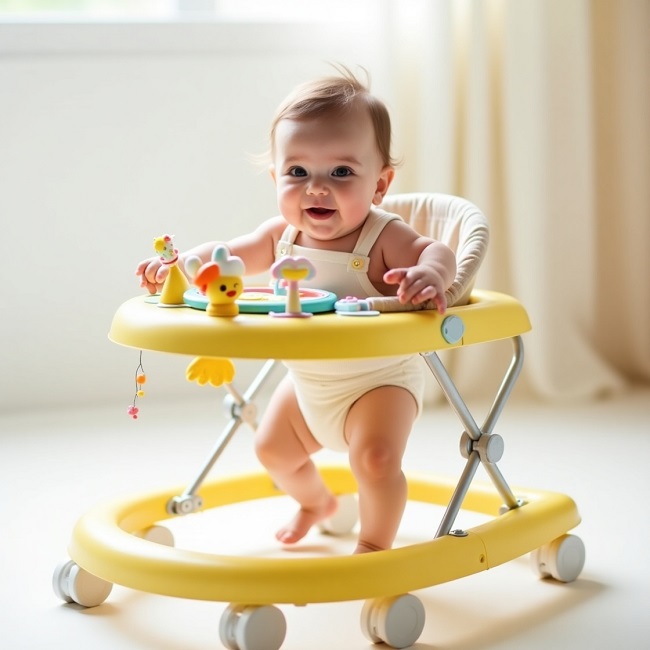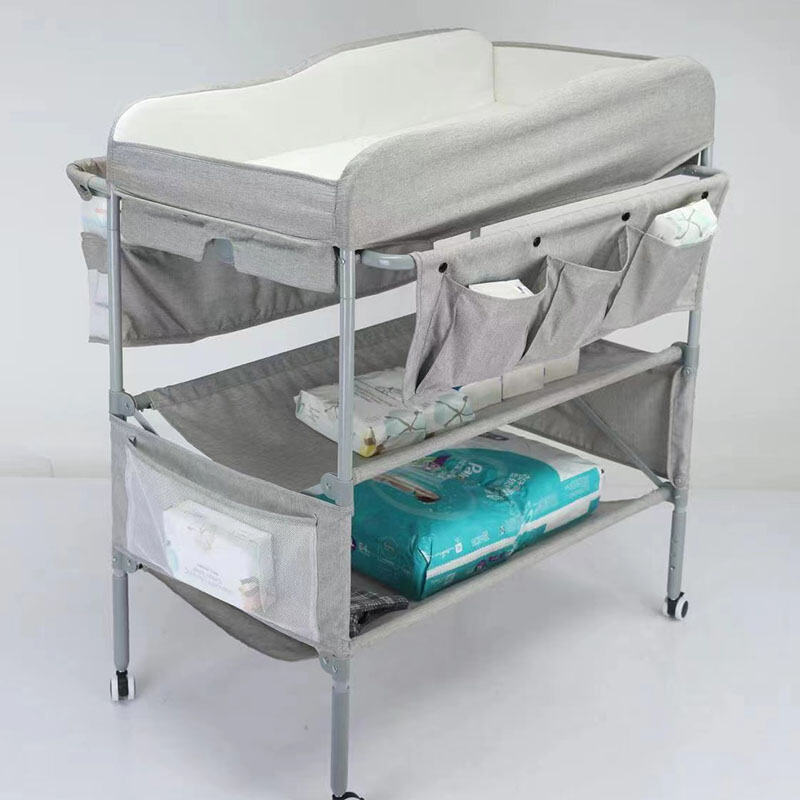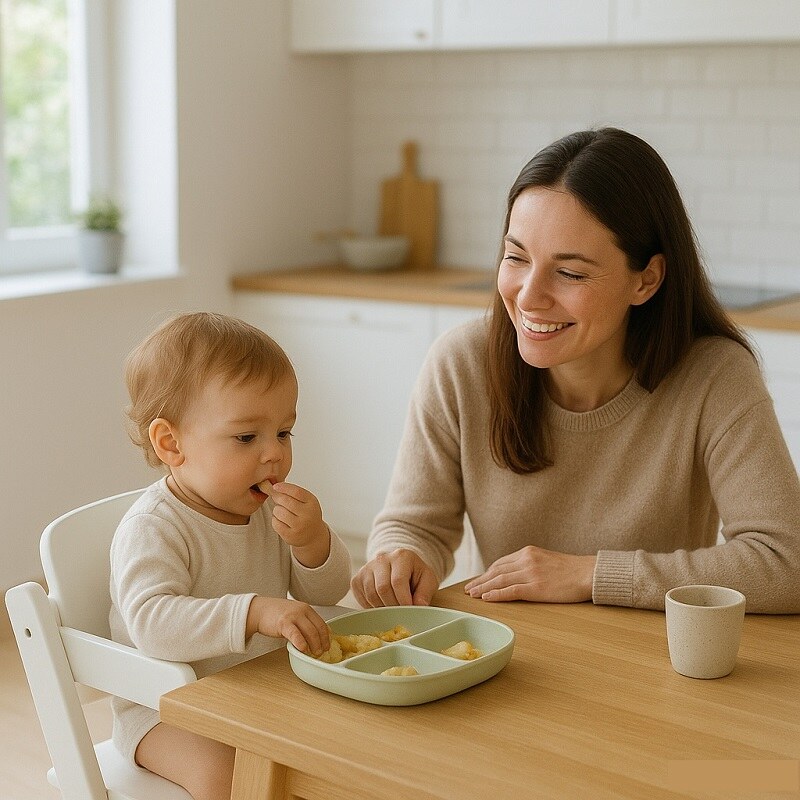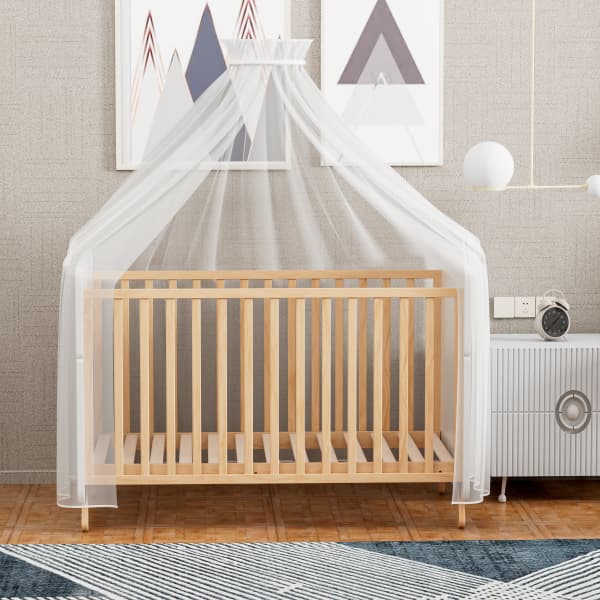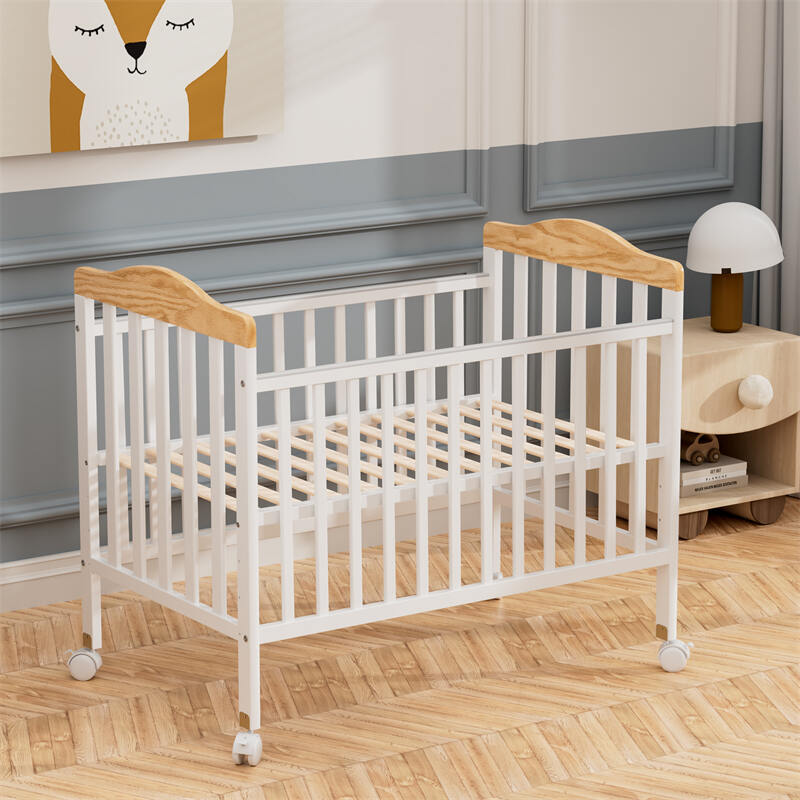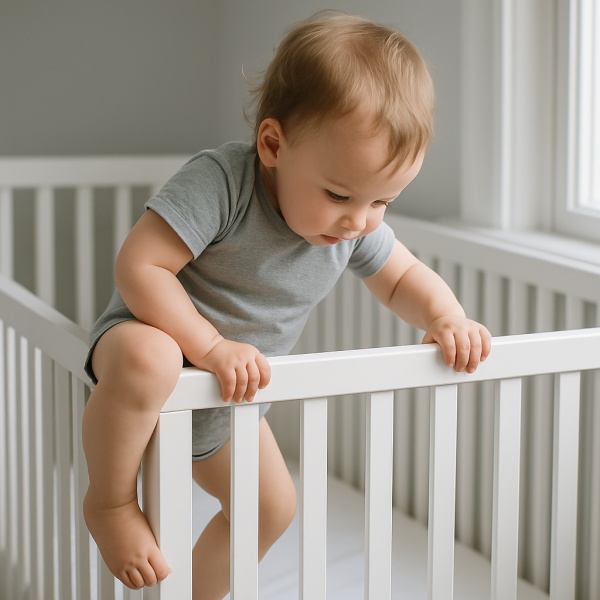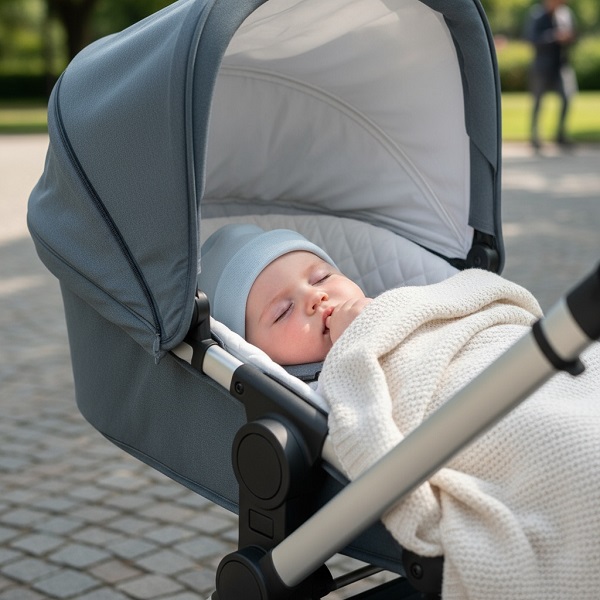Baby walkers—those wheeled seats that let your little one scoot around before they can walk on their own—are a popular choice for many parents. They can be a fun way to keep your baby entertained while giving you a brief moment to catch your breath.
You might have heard mixed opinions about them—some parents swear by them, while others avoid them entirely. The truth is, when used safely and in moderation, baby walkers can be a useful tool in your parenting toolkit.
However, safety should always come first. In this guide, we’ll walk you through everything you need to know about using a baby walker safely. We’ll cover the right age to introduce one, how to pick a secure design, the best places to use it, and essential precautions to prevent accidents.
At What Age Is It Safe to Introduce a Baby Walker?
When it comes to baby walkers, timing is everything. Most babies begin using walkers between 6 and 10 months of age, but simply reaching a certain number of months isn’t enough on its own. The real question isn’t just how old your baby is, but how developed their body is.
Pediatric experts emphasize that age alone shouldn’t determine walker use. Instead, focus on these developmental milestones, which typically align with 6–10 months:
- Head and Neck Control (6+ Months): Your baby should hold their head steady without wobbling. Walkers require an upright posture, and weak neck muscles increase injury risks.
- Independent Sitting (6–8 Months): If your baby can sit unassisted, their core muscles are strong enough to avoid slumping in a walker seat.
- Leg Strength and Weight-Bearing (8+ Months): Babies need enough strength to push off the floor with their toes. Premature use may strain hip joints or encourage toe-walking, a gait abnormality.
- Interest in Mobility: Does your baby try to pull up on furniture or “cruise” along surfaces? This signals they’re developing balance naturally—a safer alternative to walkers.
While no age is completely risk-free, 6 –10 months is the safest window—and only if your baby is developmentally prepared. For most families, supervised floor play remains the healthiest way to nurture mobility.
How to Choose a Safe Baby Walker?
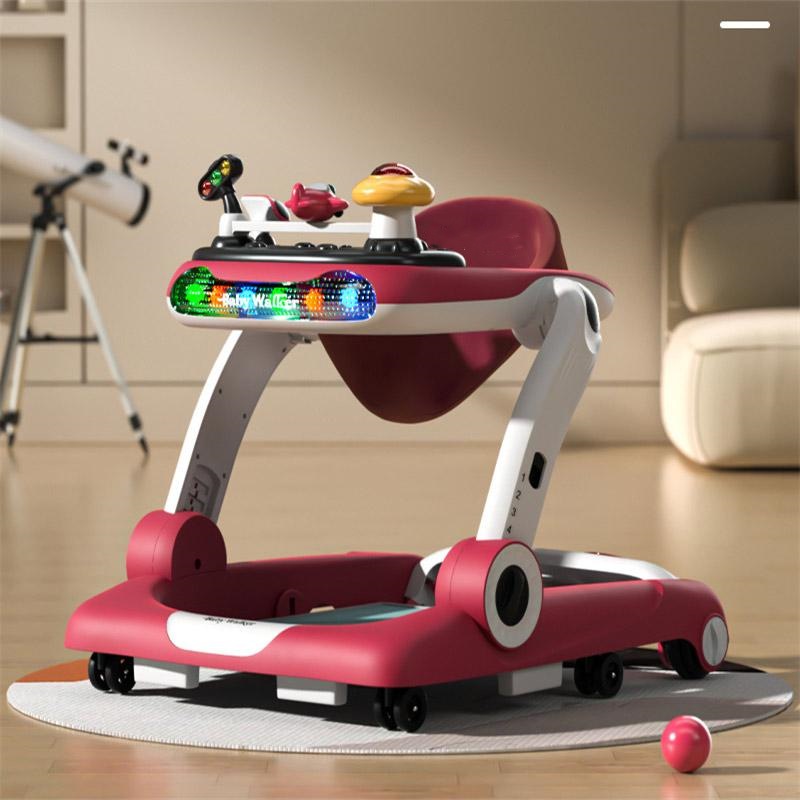
Selecting a baby walker requires careful consideration, as not all models provide the same level of safety. While walkers can offer entertainment and mobility for your little one, their design plays a crucial role in preventing accidents.
Stability & Anti-Tip Design
A well-designed baby walker includes a wide, weighted base to enhance stability and reduce the risk of tipping—especially when your baby leans forward or pushes off nearby furniture. Some models include rubberized grips or brake mechanisms that help stabilize the walker if it encounters uneven surfaces.
Speed Control & Wheel Design
One of the most common hazards with baby walkers is uncontrolled movement, which can result in collisions or even falls down stairs. To minimize this risk, opt for a walker with adjustable speed settings. Locking wheels are another useful feature, as they can convert the walker into a stationary activity center when needed.
Safety Certifications & Compliance
Never overlook safety certifications when choosing a baby walker. Look for models that meet the JPMA standards, as this indicates compliance with rigorous U.S. safety regulations. The ASTM F977 standard is another critical benchmark, covering stability, braking systems, and structural durability.
Proper Seat & Support
The ideal walker seat should be firm and ergonomic, providing adequate support for your baby’s hips and back. Adjustable height settings ensure that your baby’s feet rest flat on the floor rather than forcing them onto their tiptoes, which can strain developing muscles.
Additional Safety Features
Bumper bars with soft padding help absorb impact if the walker bumps into furniture or walls. A securely attached toy tray can provide entertainment without posing a choking hazard, as long as all small parts are firmly fixed.
What to Avoid?
Older or hand-me-down walkers – They may lack modern safety features.
Overly fast or lightweight models – These increase tipping and runaway risks.
Walkers with excessive toy attachments – Can distract from supervision.
Are Foldable Baby Walkers Safe?
Foldable baby walkers are popular for a good reason—they’re space-saving, convenient for travel, and easier to store when not in use. But when it comes to safety, parents understandably have concerns: Does the folding mechanism pose any risk? Can it collapse while in use?
The short answer is: yes, foldable walkers can be safe, but only if they are well-designed and meet current safety standards.
The primary concern with foldable walkers lies in their moving parts. Models with weak locking mechanisms can collapse unexpectedly while in use, potentially trapping tiny fingers or causing falls. Unlike rigid-frame walkers that maintain constant stability, folding joints create structural weak points that may loosen over time with repeated use.
However, modern safety-certified folding walkers address these issues through reinforced hinges and automatic locking systems that engage when fully opened. The safest models feature:
- Dual-stage locking mechanisms requiring intentional force to fold
- Audible “click” confirmation when fully secured
- Rubberized grip pads prevent accidental sliding during use
In short, foldable baby walkers can absolutely be safe, provided they are made with secure locking systems, pass safety certifications, and are used according to the manufacturer’s instructions.
How Long Should a Baby Stay in a Walker Each Day?
While they may seem like helpful tools for keeping little ones occupied, excessive time in a walker can interfere with natural movement patterns and muscle growth. Most pediatric experts recommend strict limits to balance entertainment with developmental needs.
The general consensus among child development specialists suggests no more than 15-20 minutes per day, broken into shorter sessions. That’s because walkers are not designed to support healthy, long-term physical development.
In fact, extended use can sometimes delay critical motor skills, like crawling, pulling up, cruising, and eventually walking independently.
Why? Because in a walker, babies often rely on their toes to push off, rather than using their full foot and leg muscles. Over time, this posture can reinforce unnatural movement patterns and shift weight in ways that don’t support healthy balance and coordination.
If used for long periods daily, a walker may discourage babies from building the core strength and muscle control they need for true walking.
Think of walkers as an occasional activity—not a daily necessity. If you do use a walker, keep sessions short, supervised, and balanced with plenty of floor time.
Where Is the Safest Place to Use a Baby Walker?
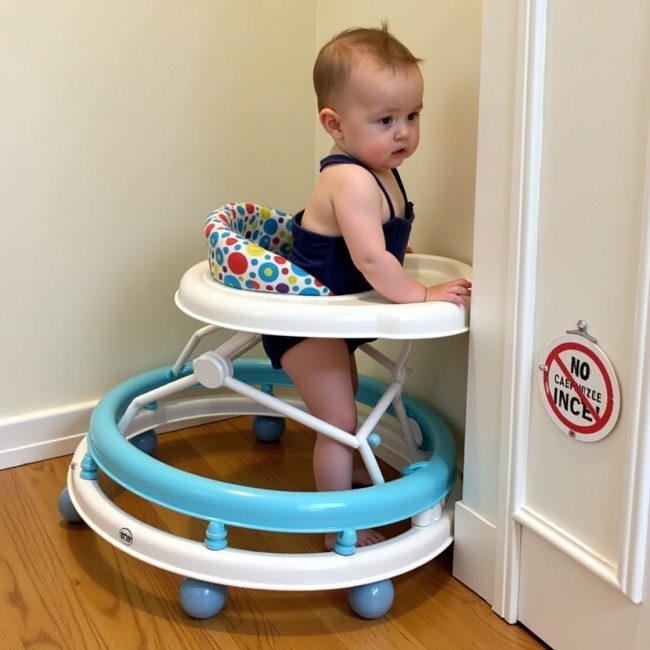
The safest place to use a baby walker is a completely flat, enclosed, and hazard-free area of your home. Ideally, it should be a room with smooth, even flooring—preferably hardwood, tile, or laminate—without thick rugs, raised edges, or transitions that could cause the walker to tip or get stuck.
Another important factor is space. Small or cluttered rooms filled with furniture, cords, or decorations are not ideal. Choose a wide, open area where your baby can explore freely without bumping into sharp corners, fragile items, or anything that can topple over.
Avoid areas near stairs, doorways, fireplaces, kitchens, or bathrooms altogether. Even a single step can pose a serious fall risk when a baby is in a walker, and it’s one of the primary reasons pediatric safety experts have raised concerns about walker use.
Some parents choose to create a dedicated play area just for walker time—like a large, gated section of a room that’s free of furniture and fully visible to you. This can offer the best of both worlds: freedom for your baby and peace of mind for you.
How to Baby-Proof Your Home Before Using a Walker?
Once your baby is in a walker, their world suddenly expands. They can glide across rooms, reach for objects they couldn’t before, and surprise you with their speed and curiosity. Before introducing a baby walker, your home needs a thorough safety overhaul.
Block All Stairways and Unsafe Rooms
Start with the basics: eliminate access to stairs immediately. Install high-quality safety gates at both the top and bottom of every staircase, and make sure they’re securely mounted to the wall—not just pressure-fitted—so they can’t be dislodged by a bump or jolt.
Kitchen and bathroom access should be completely blocked. Close doors, use door knob covers, or place gates across entrances to keep your baby confined to safer zones.
Eliminate Floor-Level Hazards
That charming rug in the hallway? It might bunch up and catch a wheel. Cords trailing from lamps or blinds? Your baby can now reach them—and pull. Be sure to identify and address potential hazards such as tripping points, low furniture with sharp corners, loose electrical cords, and unstable decorative items.
Secure Furniture and Fixtures
Unsecured furniture—especially items like bookshelves, dressers, and television stands—should be anchored firmly to the wall to prevent tipping.
Tables with sharp corners should be padded, and fragile or heavy items on low surfaces should be moved out of reach.
Protect Electrical and Choking Hazards
Electrical outlets, even those on the lower half of the wall, must be covered with secure outlet covers.
Cabinets and drawers that contain small, sharp, or hazardous objects need child locks. Items like keys, coins, batteries, remote controls, and even houseplants should be moved to higher shelves.
Create a Dedicated, Safe Play Area
Lastly, choose a designated walker-safe area—a large, flat room that’s been fully cleared of risk. If needed, you can use safety gates or a play yard to create a defined space for walker time. This area should be uncluttered, highly visible, and away from kitchens, bathrooms, and stairs.
What Are the Dos and Don’ts of Baby Walker Use?
Always supervise directly, staying within arm’s reach. Unlike stationary play, walkers require moment-to-moment attention as babies can cover three feet per second—faster than most adults can react to emerging dangers.
Use only on level, hazard-free floors after completing thorough babyproofing. Before each use, scan for new dangers like dropped coins, pet toys, or recently moved furniture that could pose entanglement or choking risks.
Adjust the walker height properly so your baby’s feet sit flat on the floor with slight knee bending. Improper height forces toe-pointing that can tighten calf muscles and alter gait development. Most quality walkers offer 2-3 height settings to accommodate growth.
Never use near stairs, even with gates installed. Walker-related falls remain a leading cause of infant head injuries, as the combination of speed and weight can break through safety barriers. Keep walkers confined to single-level spaces.
Don’t rely on walkers for containment. They’re not substitutes for safe playpens when you need hands-free time. The mobility they provide actually increases supervision demands rather than reducing them.
Special Considerations: For babies with hip dysplasia or low muscle tone, avoid walkers entirely unless approved by a pediatric orthopedist. The seated position can exacerbate existing conditions.
How Do I Stop My Baby Walker from Rolling Too Fast?
If you’ve ever seen your baby suddenly zoom across the room in their walker, you know how startling—and potentially dangerous—it can be.
The first line of defense lies in your walker’s original design. Some modern walkers come with adjustable wheel tension or built-in speed control mechanisms. These allow you to manually set how freely the wheels spin. If your walker has this feature, tightening the wheels slightly can help your baby move more slowly and deliberately.
For walkers without built-in speed controls, simple environmental adjustments can make a significant difference. Placing the walker on a low-pile area rug over hard flooring naturally slows movement while providing traction.
Proper walker adjustment plays an underrated role in speed control. When the seat height is too high, babies instinctively push off with their toes, generating more force than when their feet sit flat on the floor. This toe-pushing action not only increases speed but can lead to abnormal muscle development if sustained over time.
Most walkers offer two or three height settings—choose the one that allows your baby’s feet to make full contact with the floor with knees slightly bent. You’ll notice more controlled, deliberate movements at this proper height.
Sometimes the walker itself may be the issue. Older models or lightweight designs tend to glide too easily, while newer JPMA-certified walkers often feature wider bases that naturally resist fast, unstable movement.
Conclusion
Walkers undoubtedly offer some short-term advantages. They provide entertainment for babies craving mobility and can give tired parents brief respite. For families in small spaces without safe crawling areas, a carefully monitored walker session might seem like the only way to let babies burn energy.
Yet the risks loom large. For parents determined to use walkers, strict adherence to safety guidelines can reduce (but never eliminate) the dangers. The golden rules remain: never leave the baby unattended, always use on level surfaces, limit sessions to 15-20 minutes daily, and ensure the walker meets current safety standards.
Pairing walker time with ample floor play helps mitigate developmental concerns.
Recommended Related Articles:

